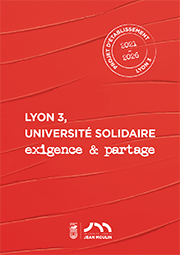AccueilRechercheProgrammes et productions scientifiquesThèsesThèses soutenuesThèses soutenues - 2006-2021Thèses soutenues - 2016
-
Partager cette page
- Recherche,
AUMERAN Xavier
La protection sociale du sportif salarié
Publié le 4 mai 2016 – Mis à jour le 14 décembre 2018
Thèse en Droit privé soutenue le 7 avril 2016.
Par son activité salariée, le sportif est intégré au système interprofessionnel de sécurité sociale. Les particularismes de l’activité sportive, tenant à la nature et à l’organisation de celle-ci, rendent néanmoins cette intégration complexe et difficile. La pluriactivité du sportif, mais également l’intervention massive des fédérations sportives, syndicats, partenaires et organisateurs de compétitions, doivent être prises en compte par le cadre normatif applicable. Il en est de même de l’importance des risques professionnels affectant le sportif et de la brièveté de sa carrière. Le système national, uniforme et public de protection sociale est alors confronté à ses limites. Tandis que la réparation des risques sociaux est insuffisante, la prévention et l’accompagnement socioprofessionnel du sportif salarié sont presque inexistants. La cadre légal applicable ne peut pleinement satisfaire. Face à ces carences, il appartient à la convention collective d’assurer une sécurité sociale professionnelle de la personne. Une protection sociale complémentaire et supplétive adaptée à l’activité sportive salariée se construit. Elle permet à la fois d’épouser les contours de la sécurité sociale et d’intégrer les dispositifs individuels et collectifs développés par les différents acteurs de l’activité sportive. La sécurisation effective de la personne est alors assurée par un cumul des formes de protection. Il s’agit ainsi de proposer une protection sociale organisée en différents niveaux s’adaptant à la réalité de l’activité professionnelle développée.
Owing to the employed activity he pursues, a paid athlete is part of the interprofessional social protection system. Sporting activities have certain specificities, due to their nature and organisation, which make their inclusion into the system more complicated and difficult. The multiple activities the athlete may carry on, as well as the significant intervention of sporting federations, trade unions, partners and organisers of sporting events, must be taken into account by the applicable normative framework. The same applies to the extent of the occupational hazards which affect the athlete and to the brievity of his career. The standardised and public national social protection system is then faced with its own limits. While the compensation of social risks is inadequate, there are hardly any prevention and socio-occupational assistance. The applicable legal framework cannot therefore be fully satisfactory. To tackle these deficiencies, collective labour agreement must ensure an occupational social protection for the individual. An additional and auxiliary social protection adapted to the status of an employed sporting activity then starts to build up. It allows both to match the outline of the national social security and to integrate the individual and collective packages designed by the stakeholders of the sporting activity field. The actual safety of the individual is then guaranteed through the combination of these different forms of social protection. The point is thus to offer a social protection organised in different layers suitable for the developed sporting activity.
Owing to the employed activity he pursues, a paid athlete is part of the interprofessional social protection system. Sporting activities have certain specificities, due to their nature and organisation, which make their inclusion into the system more complicated and difficult. The multiple activities the athlete may carry on, as well as the significant intervention of sporting federations, trade unions, partners and organisers of sporting events, must be taken into account by the applicable normative framework. The same applies to the extent of the occupational hazards which affect the athlete and to the brievity of his career. The standardised and public national social protection system is then faced with its own limits. While the compensation of social risks is inadequate, there are hardly any prevention and socio-occupational assistance. The applicable legal framework cannot therefore be fully satisfactory. To tackle these deficiencies, collective labour agreement must ensure an occupational social protection for the individual. An additional and auxiliary social protection adapted to the status of an employed sporting activity then starts to build up. It allows both to match the outline of the national social security and to integrate the individual and collective packages designed by the stakeholders of the sporting activity field. The actual safety of the individual is then guaranteed through the combination of these different forms of social protection. The point is thus to offer a social protection organised in different layers suitable for the developed sporting activity.
Mots-Clés : Protection sociale – Salarié – Sécurité sociale – Sportif
Keywords : Social protection – Employee – French social security – Paid athlete
Membres du jury :
- KARAQUILLO Jean-Pierre Professeur des universités, émérite Université de Limoges
- MORAND Michel Professeur associé Université d’Auvergne
- ASQUINAZI-BAILLEUX Professeur des universités Université Jean Moulin Lyon 3
- MORVAN Patrick Professeur des universités Université Panthéon-Assas Paris II -
- VACHET Gérard Professeur des universités émérite Université Jean Moulin Lyon 3
Président du jury : Patrick MORVAN
Mention : Très Honorable avec les félicitations
Equipe d'accueil : Équipe Louis Josserand
Documentation
Mise à jour : 14 décembre 2018







